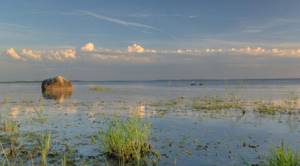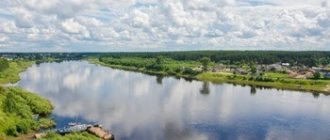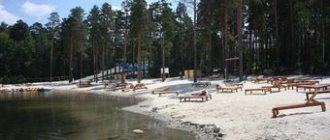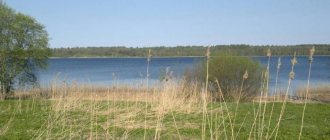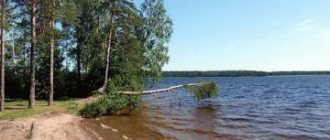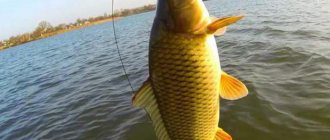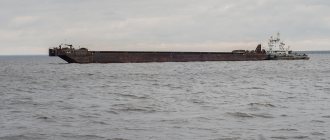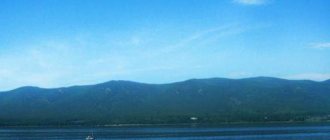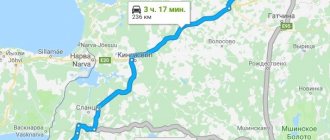Location and general characteristics
Where is Lake Peipsi located? On the territory of two states, in the very middle of the reservoir, there is a border. The eastern bank belongs to Russia - most of the Pskov region and at the source of the Narva River - the Leningrad region. The western and northern banks are in the possession of Estonia.
The lake itself consists of 3 parts:
- Chudskoe.
- Pskovskoe.
- Warm, being a strait between the other two.
The lake is located at an altitude of 30 meters. The water has zero salinity and contains a huge amount of plankton and fish.
In general, the coasts are flat, however, in the south, southeast and southwest they are quite winding, with bays and islands.
Description of Lake Peipsi - geography, nature and climate
Geography
In principle, Chudskoye is rarely considered as a separate body of water, since it is part of the Chudsko-Pskov lake complex. This complex consists directly of Lake Peipus itself, Lake Pskov and the lake located between them, called Tyoploye.
In our case, we will consider exclusively Chudskoye (2670 sq. km), which is the basis of the entire Chudsko-Pskov complex, as it occupies 73% of its area.
In terms of size, the reservoir ranks fifth in Europe. Its length is 96 km and its width reaches 50 km. As for the average depth, it is 7.5 meters. In turn, the greatest recorded depth of Lake Peipus is determined by 16.6 meters. As you know, Lake Peipus is a border reservoir, where the border between Estonia and Russia runs approximately along its middle.
At the same time, the coast, which belongs to Estonia, is swampy and low-lying, so in the spring it is often flooded. In turn, the Russian coast is more elevated and is characterized by small swampy areas that alternate with hills and dunes.
And here's what you need to know: How to rig a worm to catch crucian carp || Silicone worms for a float rod
The nearby hills are abundantly covered with pine trees. At the same time, there are quite a lot of places that are defined by a large accumulation of boulders.
More than thirty rivers and streams flow into the lake, and only the Narva River carries its waters from the lake. The large bays of Lake Peipsi include: Lakhtinsky, Zhelchensky and Raskopelsky. As for the large islands, Želaček can be distinguished here, and the largest tributaries include the river Emajõgi.
Climate
The winter season on Lake Peipsi begins towards the end of November and ends in early April. Ice is established throughout the lake and its thickness is usually the same everywhere (about 70 cm). At the same time, the temperature background of the water has an inverse distribution, that is, at the surface the water is determined by zero temperature, and at the bottom it reaches plus two degrees.
In turn, the summer period is determined by a duration of 130 days. This period can be classified as moderately warm, which is characterized by frequent rains of varying intensity and short duration.
During the hottest month (July), the water temperature in the lake can rise to 25 degrees. The bottom of the reservoir is flat, and the depths are shallow; the lake warms up effectively, which leads to the development of a food supply for fish.
With the onset of autumn comes cloudy weather, determined by persistent rains, which are supplemented by snow and fog in November.
Nature
Battle on the Ice
In the history of Lake Peipsi there is a great event called the “Battle of the Ice”. This event took place in April 1242, when the reservoir was still covered with ice. The day of the victory of Russian troops over the knights of the Teutonic Order is considered a day of glory and is celebrated to this day on April 5. Although there is still a lot of debate as to whether there really was a battle on ice. First of all, it was April, and even if there was ice, it was not very thick. Secondly, the total weight of a person in armor and with a horse is about 600 kilograms. Could you withstand the ice of several people at the same time?
origin of name
Today the reservoir is called Chudsko-Pskovsky because of the adjacent Pskov region.
It is believed that the word “Chudskoye” has Finno-Ugric roots and means “wonderful people.” And the term was applied to Estonia. It was the Finns and Ugric peoples who lived on the shores of the lake, so there is a rational idea in translating the name.
There are other “names” - Peypus and Peypsi-yarv. These names are already of Estonian origin and are translated as “lake”.
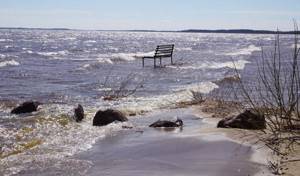
Economic importance
On the hills above the lake there are agricultural lands and villages. The largest city on the Russian coast is Gdov; on the Estonian coast the towns of Kallaste and Mustvee stand out. The beauty of the landscapes of Lake Peipsi has long attracted the attention of poets, writers and artists from Russia and Estonia.
The lake also features shipping; The trade and commercial direction is of little significance due to the shallowness of the lake. Mainly represented are tourist ferries with an internal orientation. The recreational potential is generally underdeveloped; the tourism and transport infrastructure has been somewhat more modernized on the Estonian side thanks to Western lending, the source of which dried up after the 2008-2009 crisis. The local population (Russians, Estonians) is mainly engaged in agriculture and fishing.
Geographical characteristics
Many inhabitants of the planet know exactly where Lake Peipus is located, because it is the 5th largest body of water in Europe.
The reservoir is about 96 kilometers long and 50 kilometers wide. The deepest point is 16.6 meters. The average depth of the lake is 7.5 meters.
Lake Peipsi in Russia and Estonia is fed by snow and rain. In addition, more than 30 rivers and streams flow into it. The most significant: Tansy, Embah, Velikaya and Voo.
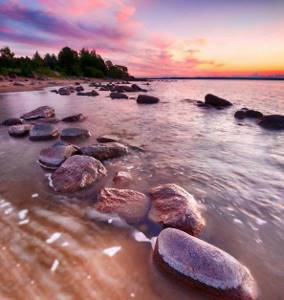
Lake Peipsi
Basic moments
The length of the lake is about 96 km, width - up to 50 km, average depth - 7.5 meters, maximum depth - 16.6 meters. Over 30 rivers and streams flow into the lake, fed by snow, rain and spring water. Only one border river, Narva, flows out and flows into the Narva Bay of the Gulf of Finland in the Baltic Sea. Water salinity is 0 ppm. The lake is rich in plankton, and therefore fish.
On the ice of Lake Peipus on April 5, 1242, the famous Battle of the Ice took place - the battle of the Russian army of Prince Alexander Nevsky against the troops of the Livonian Order. Due to the variability of the hydrography of Lake Peipsi, historians for a long time were unable to accurately determine the place where the battle took place. Only thanks to long-term research carried out by an expedition from the Institute of Archeology of the USSR Academy of Sciences, the location of the battle was established. It is located approximately 400 meters from Cape Sigovets.
Shores of the lake
The northern shore of Lake Peipsi consists for the most part of a continuous series of dunes extending far into the local surroundings; The height of the dunes in some places is up to 8.5 meters, and near the village of Sirenets, located on the left bank of the Narova River, 1.2 kilometers below its source from the lake, the dunes reach a height of 10.5 meters. As you move from the northern to the western coast, the dunes gradually become smaller and the low-lying, flat coast is covered in places with alluvial boulders, some of which reach 2.4 meters in length.
At the westernmost depression of the coast near the village of Chernaya, minor dunes again appear, and to the south, closer to the village of Koddafer, the coast consists almost entirely of boulders of Finnish granite.
The eastern coast from Sirenets to Gdov is a low dune, behind which the area gradually rises.
To the south of Gdov, the coast consists of deluvial clays with alluvial boulders, in places it rises to 9 - 12 meters in height, interrupted by dune formations in gorges through which rivers and streams flow.
In the southwestern corner of the lake there is Raskapel Bay, 20 km long, bounded on the north by spits and the island of Borok.
The shores of the bay in some places are sheer walls of colluvial clay up to 5.4 meters in height, and in some places the shore is low with hills of wind-blown sand.
Near Podborovye, the shore of Lake Peipus ends in a steep cape up to 9 meters in height.
In the southern part of Lake Peipus there is a significant island called “Zhelachek” or “Mezha”. The eastern part of this island rises to 4.2 meters and is home to the villages of Pirisaar and Zelachek. The rest of the island is low-lying, swampy, and the village of Porca, located on the northwestern coast, is subject to occasional flooding.
The western coast becomes more monotonous, low and meadow-like, sometimes flooded during high water, and low, destroyed dunes stretch along its very edge.
Climate
Due to the presence of lakes, the climate of the region is somewhat similar to the sea and is generally considered moderately cold and humid. The average annual temperature ranges from 2 to 4 degrees Celsius; in winter, frosts of up to 30 degrees are not uncommon here, but they are quickly replaced by thaws. This area is also characterized by high cloud cover; during the year there are from 170 to 220 days of precipitation, most of which occur in spring and autumn. Lake Peipsi freezes at the end of November - beginning of December, and then snow cover is established. The period of ice drift occurs at the end of April - beginning of May.
Summer here is considered to be the period after the last spring frosts and before the first autumn frosts. Summer temperatures are quite comfortable; during the day the thermometer rarely reaches the 30-degree mark.
Beaches
The beaches on the lake are sandy and very comfortable. But it should be noted that the most beautiful one is located on the Estonian coast, this is Kauksi beach, known not only for its picturesqueness, but also for its “singing” sands.
Camp sites
There are many boarding houses, tourist centers and children's camps on the shore of the lake. All of them are in steady demand in the summer months: the beautiful area and healthy ecology are the main reasons for this. In winter, many of them are closed.
One of the most attractive havens on the shores of Lake Peipus is the “Peipus Compound” - a recreation center, which includes 47 cottages of four different categories, the “Bear” restaurant, a sanitary block, a conference room, and a free guarded parking lot. Each cottage, regardless of category, has a terrace with a wonderful view of the lake. The cottage community is located directly on the shore of the lake, at the entrance to the village of Spitsino, which is 90 km from Pskov.
Entertainment, excursions and attractions of Lake Peipsi
The largest city on the Russian coast is Gdov (among the attractions here are the Cathedral of the Sovereign Mother of God and the Gdov Kremlin, first mentioned in the chronicle in 1323 and which once had important defensive significance). 71 km from it is the Kobylye settlement, and in it there is the famous “crow stone”, from which Alexander Nevsky led the Russian troops during the Battle of the Ice. There are, however, other versions of the location of this stone.
In the village of Samolva there is a museum, the exhibits of which tell how the expedition of the USSR Academy of Sciences searched for the site of the Battle of the Ice. Schemes, maps, scientific reports, justifying search directions, unique photographs are of undoubted interest for anyone interested in the history of Russia.
In the village of Domozhirka, near the lake, you can see the Church of the Holy Trinity, built here in the 15th century. Of interest are the Church of Peter and Paul in the village of Vetvenik, the Church of the Intercession in the village of Ozera and the Church of St. Nicholas in Remda.
Historical reconstructions
For lovers of historical reconstructions, it will be interesting that every year, on the first or second Sunday of April, the anniversary of the Battle of the Ice is celebrated here. For this holiday, reenactors from Belarus, Ukraine, Poland and the Baltic republics come to the shores of Lake Peipsi. Exhibition tournaments are held with the most accurate depiction of historical details and leave a strong impression on spectators. But even more impressive are the unstaged battles of the reenactors, in which they zealously defend the honor of their clubs.
Fishing on Lake Peipsi
The entire lake basin is famous for its fishing, which is the main occupation of the coastal residents. The waters of Lake Peipsi are home to approximately 22 species of lake-dwelling fish. Particularly famous is the Pskov smelt, yellowish in color, which is the most important item of lake fishing and local export. In addition to smelt, the most famous species are pike perch, salmon, burbot, bream, roach, ruff and pike. Fishing is carried out by the inhabitants of flat, sandy and swampy shores with sandy mounds on which fishermen's huts huddle. The main fishing center is the Talab Islands. In winter, fishermen migrate to the lake itself, transporting light huts built from birch bark to its motionless icy surface, which, gradually grouping together, form something like villages.
Ichthyofauna and birds
Where Lake Peipus is located in Russia, the shores are characterized by swamps and forests, mainly pine. Spruces have survived only in rare places. The second tier of forests usually consists of mixed plantings with aspen, birch and rowan. Among the bushes there are many lingonberries, blueberries, and ferns.
There are few meadows on the banks, and, as a rule, they are located near populated areas. On the very shore, near the water, reeds, reeds, cattails, and iris grow.
It’s clear where Lake Chudsko-Pskovskoye is located - this is a place where there are a lot of fish, about 35 species. There are commercial species here: vendace, pike perch, eel, Chud whitefish, smelt. Salmon enters the Narva River. Smaller lakes contain fewer fish, about 24 species.
The greatest species diversity is in the Zhelcha river - 29, in Chernaya - 24. In calm waters, perch, crucian carp, gudgeon, roach, dace and loach are most often found. Where there is a fast current, there is grayling, rare for this region.
The shores of the lake are also rich in representatives of birds, there are 36 species of them, these are only waterfowl:
- geese;
- cormorant;
- diving ducks;
- coots;
- black-throated loon;
- little ones.
Of these species, 12 are classified as migratory - these are the duckling, gray goose, whooper swan and others.
There are many more waterbirds - about 50 species. These are the gray crane, gulls, waders and passerines. Woodpeckers, chickens, and birds of prey live in the forests. Closer to populated areas - white stork, pigeons and passerines.
Fishing
It is here that many fishermen come, although Russian amateurs claim that the catches are better on the Estonian side. This is due to the fact that the lake is deeper there. However, people come to the lake in summer and winter.
| Name | Where and how to catch |
| Roach | You can fish from the shore or from a boat, using crumbs or bloodworms |
| Pike | This individual can only be caught from a boat; it is quite difficult to guess what day it will bite on. |
| Perch | The easiest way to catch it is where the seagulls fly |
| Ruff | If this fish is caught on the fishing rod, then there is definitely no other fish in the area. |
| Chudskoy smelt | Loves calm waters, weather without wind and rain |
| Bleak | As a rule, it swims in whole flocks, but is very agile and nimble |
| crucian carp | This fish prefers quiet backwaters, in places where the water is overgrown with vegetation. |
Winter season
A favorite place for fishermen on Lake Peipus in summer is the Talab Islands. They were a fishing center until the 90s.
And all thanks to the collective farm named after Zalita. The water in the reservoir is absolutely transparent in summer.
Here you can see almost everything to the very depth. And even from a boat you can watch the movement of schools of fish.
She is ready to peck everywhere, even at a meter depth. The most popular biting period is April and May.
The fish are most actively caught on the hook during this period. Moreover, you can use any gear and choose any places: small streams or ditches.
When you come to the lake in winter, you can stay in your car. There is also the option to choose one of the cottages located on the shore of the lake.
It’s all very convenient, and it costs about a thousand rubles per day. IN 1.
The best roach habitats are located 5-2 km from the coast. After all, it is she who is most often caught in winter.
Don’t forget to bring a sled with you, on which you can put all the necessary things or your catch.
You don’t have to settle in one place right away. First, drill a small hole and fish for 15 or 20 minutes. If the fish starts to bite, then feel free to stay in place. But if there is no result, then change the place of fishing. Do not forget that winds are a frequent occurrence on Lake Peipsi, especially in winter.
So you need to grab a good two-person tent, in which you can practice your hobby in comfort and convenience, and at the same time not be afraid of strong winds. If you adhere to all the above rules, then fishing will go with a bang. You will definitely bring home a big catch and make your family and friends happy.
It is here that many fishermen come, although Russian amateurs claim that the catches are better on the Estonian side. This is due to the fact that the lake is deeper there. However, people come to the lake in summer and winter.
And now you can consider the description of fishing on Lake Peipsi. Fishing enthusiasts recommend going to the Talab Islands in the summer. These places have been a fishing center since the 90s of the last century.
The water here is perfectly clear and you can even see the bottom in some places. Naturally, when sailing by boat, you can clearly notice schools of fish. The bite in the area of the islands is ideal almost everywhere, even if the depth is no more than 1 meter. The best time to come here is from April to May. It is during this season that the bite is active, almost any gear is suitable.
And here's what you need to know: Photos of fishing rods
It is worth remembering that when there is a strong wind, strong waves arise on the lake, so it is not recommended to go out by boat. For those who want to taste their own catch, fry fish or cook fish soup, there are about 22 islands on the lake.
Fishing on Lake Peipus in winter is no worse. If you want to come overnight, you can spend the night in your car or stay in a cottage.
The best fishing is at a distance of 2 kilometers from the shore. Most of all there are roaches in winter. It is not recommended to settle in only one place; it is better to make several holes.
In winter, there are often strong winds on the lake, so it is recommended to have a tent to protect yourself from it.
The lake is huge, there is enough space and fish for everyone. The bite is good, so it is difficult to remain without prey.
But they are harsh towards poachers here, and trying to pirate is more expensive for yourself. So before you start fishing, it is better to coordinate all the nuances (fishing locations and its rules) with the fisheries inspectorate. Otherwise, problems and large fines are guaranteed.
What kind of fish can you catch?
The lake is famous for the abundance and variety of commercial fish of valuable species. Such wealth is provided by an ideal food supply. The lake is shallow, warms up thoroughly and quickly, so plankton reproduces just as well and at high speed.
More than forty species of fish live here, of which the most desirable for fishing enthusiasts are pike, bream, whitefish, pike perch, perch, roach, and smelt.
Summer fishing
The opening of the season usually occurs from mid-April to early May. Even from the shore at this time, perch, ruff, and roach are already well caught. In deeper areas there are often schools of pike perch and pike perch, and even pike can be found. When fishing at even greater depths, you can catch quite large bream using a simple vertical spoon.
But in summer, the most successful fishing is at great depths or in reed thickets. Almost all year round you can easily catch perch or roach.
There are also vendace with smelt, but rarely. A good catch of this fish can be considered a fishing success.
Summer is a favorable season for a systematic survey of the lake to find fish sites. Having an accurate map of the depths of the lake and a good motor boat, you can slowly and methodically catch fish in their expected habitats in order to find such a site.
Winter fishing
With the appearance of the first ice on the lake, fishing continues. The object of the hunt is again bream, roach and perch. They are caught with a jig or spoon.
At the same time, while it is not very cold, you can try to catch pike perch, pike or whitefish. If you are not very lucky, try again, after frost, on the last ice.
As the frost intensifies, burbot, the main object of hunting, comes out of hibernation. In January - February, experienced fishermen take night watch for this fish.
Lake Pskov is a real place of pilgrimage for fishing fans. Here there is expanse and abundance, ideal conditions for rich mining at any time of the year.
As already mentioned, Lake Peipsi is rich in fish stocks, and the picturesque nature and close location to cities makes this place truly the most popular among fishermen. At the same time, preference is given not only to summer fishing, but also to winter fishing.
Fishing in the summer season
And now you can consider the description of fishing on Lake Peipsi. Fishing enthusiasts recommend going to the Talab Islands in the summer. These places have been a fishing center since the 90s of the last century.
The water here is perfectly clear and you can even see the bottom in some places. Naturally, when sailing by boat, you can clearly notice schools of fish. The bite in the area of the islands is ideal almost everywhere, even if the depth is no more than 1 meter. The best time to come here is from April to May. It is during this season that the bite is active, almost any gear is suitable.
It is worth remembering that when there is a strong wind, strong waves arise on the lake, so it is not recommended to go out by boat. For those who want to taste their own catch, fry fish or cook fish soup, there are about 22 islands on the lake.
Entertainment and attractions of Lake Peipsi
The largest city on the Russian shore of the lake is Gdov. Its main attractions are the Cathedral of Our Lady of the Sovereign and the Gdov Kremlin, which was first mentioned in the chronicle in 1323 and once had important defensive significance. 71 km from Gdov is the Kobylye settlement, and in it you can see the famous Raven Stone, from which Alexander Nevsky, according to legend, led the Russian troops during the Battle of the Ice. However, this is not the only stone that claims to be of historical significance: there are nine such places in the vicinity of the lake!
In the village of Samolva there is a museum where you can learn how an expedition of the USSR Academy of Sciences searched for the site of the Battle of the Ice in the 1970s. Here are diagrams, maps, scientific reports, arguments for search directions, and unique photographs.
In the village of Domozhirka, near the lake, you can see the Church of the Holy Trinity (15th century). In the village of Vetvenik, the Church of Peter and Paul is interesting, in the village of Ozera - the Church of the Intercession, in Remda - the Church of St. Nicholas.
Historical reconstructions
Every year, on the first or second Sunday of April, the anniversary of the Battle of the Ice (April 5, 1242) is celebrated here. Reenactors from Belarus, Ukraine, Poland and the Baltic republics come to the shores of Lake Peipsi. Exhibition tournaments are held with the most accurate depiction of historical details and leave a strong impression on spectators. Another highlight of the program is the unstaged battles, when reenactors zealously defend the honor of their clubs.
Fishing on Lake Peipsi
There is a lot of fish in the lake; people come here for bream, pike, pike perch, burbot, ruffe and roach; you can also catch silver bream, whitefish, vendace or rudd. In total, the lake is home to more than 40 species of fish; it is considered the most fishy reservoir in the north-west of Russia. This factor, as well as the lake’s proximity to cities and the picturesque shores, make it popular among fishing enthusiasts, including ice fishing. In general, the fisherman’s pride will not suffer!
Rest
You can do more than just fishing on Lake Peipsi. Although the infrastructure on the banks of the reservoir is not yet very developed, there are still several recreation centers where you can settle and live in decent conditions. Today there are three popular places:
- “Chudskoye Compound” is 47 houses with comfortable living conditions. Holidaymakers can enjoy cycling, catamarans and fishing. Naturally clean lake shore.
- “Kudykina Gora” - the emphasis is on winter recreation, there are gazebos with barbecues, fireplaces and karaoke. Horseback riding and paintball areas are available.
- “Friend” - Perhaps the most economical option. On the territory there is a boat station, barbecues, a bath complex and a clean beach.
Naturally, many people go to the lake as “savages”, wanting to completely immerse themselves in natural living conditions and go fishing.
Recreation centers
Most of the tourist and fishing bases of Lake Peipus have an acceptable infrastructure to create comfortable conditions for lovers of active recreation, including rental of fishing equipment, rental of boats, catamarans, and in winter - skis and snowmobiles. Almost every base has a Russian bathhouse, barbecue areas, and gazebos.
Camp sites are popular among tourists:
- Chudskoye Compound is a cottage community in the village of Spitsino, the cost of living ranges from 1200 to 6500 rubles per day;
- Prichudye - accommodation for tourists is offered in small cottages on the banks of Narva near the village of Skamya, daily price - from 3,000 rubles;
- Friend – offers rooms in a guest house and separate houses for accommodation, as well as the possibility of staying in a tent camp. The cost of renting a house is 3,000 rubles, beds in a guest house are from 500 rubles, and for a tent you will have to pay 250 rubles per day. The base is located in the village of Zalahtove near Sorokovy Bor, the beach is shallow and suitable for families with small children;
- Far Away Kingdom - also located in the village of Zalahtove, has its own yacht club and restaurant. Accommodation in a guest house or hotel will cost 2000-2500 rubles per day, renting a two-story cottage will cost a maximum of 20,000 rubles;
- Ustye Beach Resort is a country club in the village of Ustye, consisting of 16 cottage houses that can accommodate from 5-7 people. The total cost of renting such a house is 5,000 rubles per day.
How to get there
From St. Petersburg to the nearest point on the lake where you can relax is about 250 kilometers. You need to travel along the E20 and E360 highways. After the city of Pskov, the journey will take no more than half an hour.
It is not necessary to have personal transport; you can also get to the lake using public transport. A bus departs from St. Petersburg to Pskov on a regular basis (No. 994). The stop from where the bus departs is located near the Ligovsky Prospekt metro station. Departure daily at 15:30. The bus arrives at the Chudskoye Compound cottage complex. Travel time is about 5 hours.
You can also go to Gdov station from the Baltic railway station. The train departs daily at 7:05, and from the Gdov station you can take a taxi, or the recreation center will provide a transfer.
